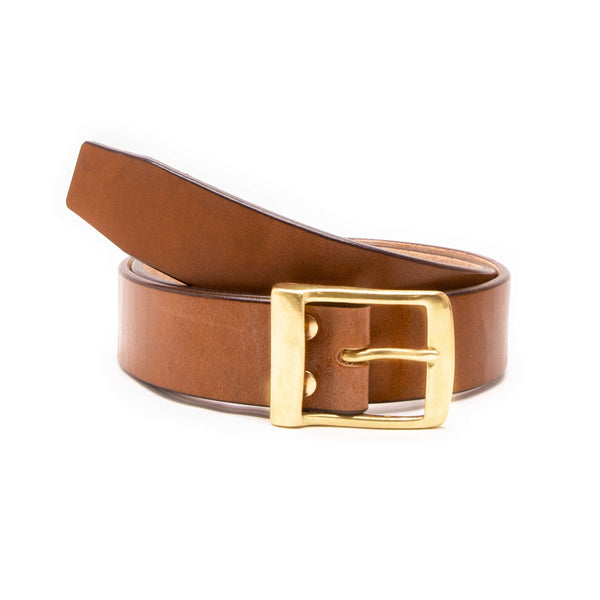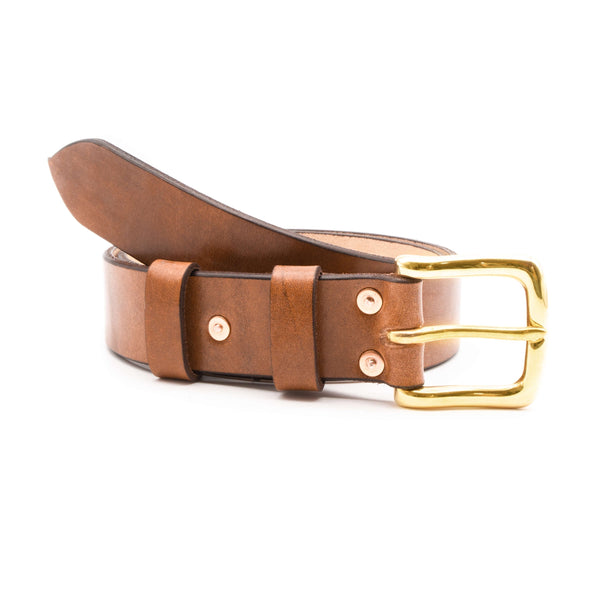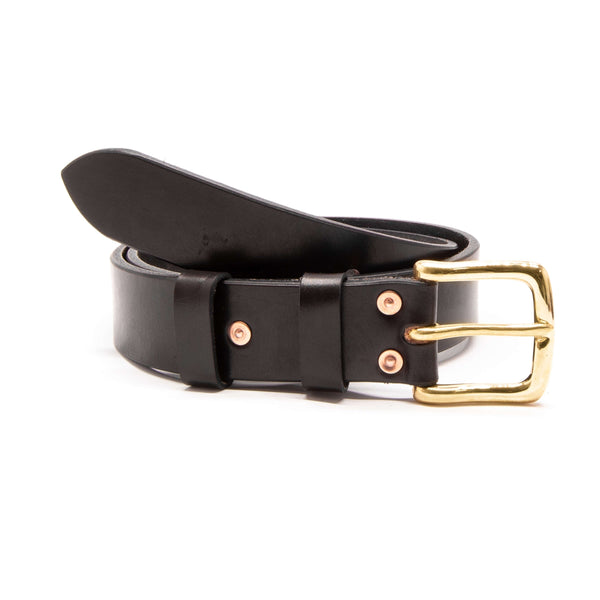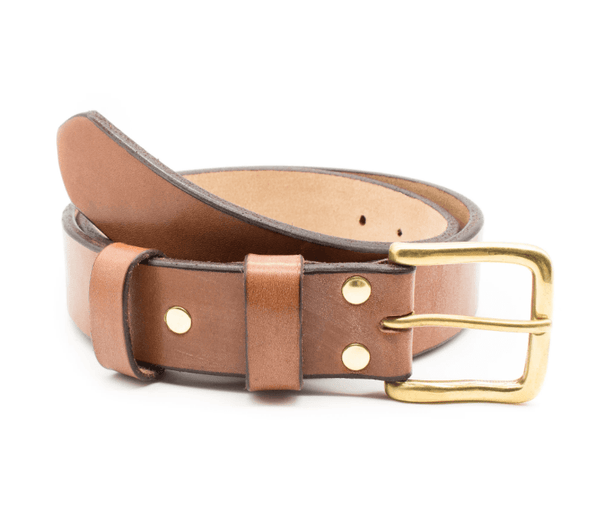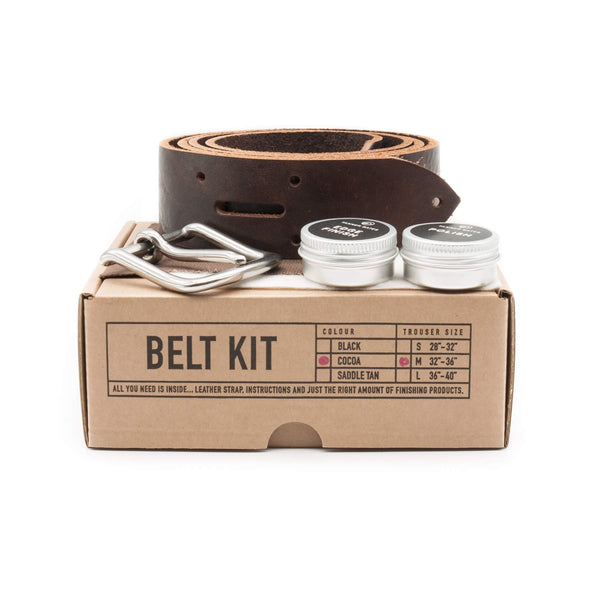
Leather Belts
Traditional Handmade Leather Belts of Exceptional Quality.
Our handmade leather belts are crafted in our workshop with the finest leather, here in the UK. Made from premium leather and using traditional saddlery skills and hand tools, they're built to last. Featuring sand cast solid brass buckles, if you take care of your belt, it will last you a lifetime.
A wide selection of sizes means Tanner Bates' leather belts are great for both men and women. Choose from a selection of black belt and brown leather belts, using both vintage and new leather. The OBT belt is one of our most popular styles, using Oak Bark Tanned leather with the option of vintage leather.
Devon Oak Bark Tanned Leather has a long tradition in the UK with classic designs, which modern industry has left far behind. Oak bark contains the necessary tannins to transform Devon cowhides into leather and, after a process that takes at least a year, results in a durable yet supple hide with a strong smell of leather. See the various options below.
The Birth of the Leather Belt: A Historical Exposé
From the dawn of civilisation, humans have sought to not only cover but also adorn their bodies. Crafted from nature's offerings, the real belt is an accessory that has stood the test of time. Its journey from a simple utility item to a fashion statement reflects the evolution of human needs, tastes, and creativity. We will delve deep into the history of the genuine leather belt, tracing its genesis and its impact on society over centuries.
The Genesis of the Leather Belt - The Bronze Age (3300 BC - 1200 BC)
The Bronze Age: An Era of Innovation
The first known documentation of belt made from leather trace back to the Bronze Age, an era notable for technological advancements in urban civilisation, including the usage of bronze and primitive forms of writing. The Bronze Age, starting around 3300 BC in the Middle East and slowly progressing through Europe until 1200 BC, saw the first iterations of the leather belt.
Early Utility of Belts
Originally, belts were more than just fashion accessories; they were tools of survival. The first belts, also known as military girdle bands, were worn around the waist to hold weapons in place. These utilitarian accessories were made of leather, prized for their durability and flexibility. The Roman military, for instance, found the leather belt particularly useful, granting their soldiers freedom of movement while also offering some protection.
Belts Beyond Utility - Cultural and Symbolic Significance
The belt found a place not only in the wardrobes of the ancients but also in their cultural narratives. For instance, in Mongolian culture, the exchange of belts was a ritual to seal alliances. The Franks, on the other hand, believed that capturing an enemy's belt symbolised victory. The belt's significance has endured, with modern combat sports like boxing still crowning their champions with a belt and martial arts using coloured belts to symbolise skill ranks.
The Belt as a Dream Symbol
Interestingly, belts also found a place in dream interpretations in certain cultures. A belt in a dream could symbolise a range of concepts, from personal boundaries and life struggles to power and strength, further demonstrating its cultural significance.
Leather Belts in the 19th Century
Military Fashion & the Advent of the Waist Belt
In the 19th Century, real leather belts continued to play a dual role as a decorative and practical part of military uniforms, particularly among officers. Officers often wore tight, broad belts around their waists, both to hold a sabre and for aesthetic reasons. The belt helped achieve a trim physique, akin to the much-aspired V-shape in today's fashion.
The Emergence of Belt Loops
Although men in Europe had started wearing trousers in the 16th Century, it was not until the mid-19th Century that trouser waistlines fell to a lower line and belt loops were created. This evolution saw the belt transcend its military utility to become an essential fashion accessory.
Women and Leather Belts – A Historical Overview
Women's Belts in the Middle Ages
Women started wearing belts much later than men, but, similar to their male counterparts, they initially did so for utilitarian reasons. Medieval women used their belts to carry their purses and fans, making the belt a predecessor of the modern bag.
The Evolution of Women's Belts
With the invention of the handbag and the popularity of blouses and long skirts, belts were free to lose their utilitarian character and become more of a style statement. Waist belts remain popular to this day but women have also been using belts for trousers since the 1930s.
The Modern Leather Belt - A Fashion Statement
The Contemporary Belt
Over centuries, the evolution of the leather belt has been impressive. Today, the variety of belts is vast: from classic to braided belts, from sports belts to dress belts, and from faux leather to exotic quality leather belts. While functional belts like tool belts for handymen still exist, the belt is now primarily an ornamental accessory playing an important role in ever-changing fashion trends.
Leather Belts for Women
For women, the leather belt has transformed into a versatile fashion accessory. Today, a belt can harmonise an entire outfit when combined with other accessories, add a dash of class or colour to a casual outfit, and even accentuate a small waist or flatter fuller figures.
Leather Belts for Men
For men, the leather belt has become an indispensable accessory. The unspoken sartorial rule of matching the colour of the belt with the shoes is particularly true for formal attire. As men typically have fewer accessory options compared to women, the few they do have, such as the leather belt, become all the more significant.
The Journey of Leather - A Material Perspective
The Early Ages of Leather
The first leather belts can be traced back to the Bronze Age, around 3000 BC to 1050 BC. These early belts, however, looked very different from the belts we are familiar with today. Leatherworking had yet to be fully developed, and early belts were typically crafted from softened tree bark and gathered cloth pieces.
Early Leatherworking Techniques
As leatherworking techniques progressed, leather started to become a commodity valuable enough to trade. It was used to carry weapons and other useful items. Before the development of leatherworking techniques, stiff pieces of animal hide would be found to rot in the sun. Then the use of animal fats would eventually enhance the flexibility of the leather, and aldehyde, sourced from burned leaves, was used to tan the leather.
The Advent of Modern Leatherworking
Fast forward to the 19th Century, leatherworking had advanced significantly. New tanning methods, like chromium tanning, were developed. This process is faster than vegetable tanning and results in a softer, more pliable leather that's suitable for a wider range of applications, including clothing and upholstery.
The Leather Belt - From Prehistory to 3000 BC
The Stone Age saw the first signs of leather being used as a material to create clothing and construct shelters. Leather, in these times, was prepared by using bone awls to create holes in hides, marking a significant advancement in the art of leather craft.
Leather Belts in the Iron Age (1200 BC - 600 BC)
During the Iron Age, belt buckles and metal hooks started to be cast from bronze, often reinforced with an iron core. This era also saw advancements in leatherworking, with leather becoming a valuable commodity used for carrying weaponry and other items.
Leather Belts in the Middle Ages and Early Modern Period (5th to 18th century A.D.)
During the Middle Ages and Early Modern Period, leather belts became a decorative as well as a utilitarian part of military uniforms. The belt's importance was further emphasised by its usage as a symbol of wealth and status during this era. Highly decorative belts were associated with higher classes and nobility.
The Leather Belt in the 21st Century
Today, the perfect belt is more than just a functional accessory; it is a quintessential part of modern fashion. The variety of leather belts available today is a testament to human creativity and craftsmanship over centuries. Whether it's a simple black leather belt paired with a business suit, a chunky belt worn over a flowing dress, or a rugged belt holding a craftsman's tools, the leather belt remains a timeless accessory created with traditional saddlers skills connecting us to our ancestral past and continuing to shape our fashion future.


